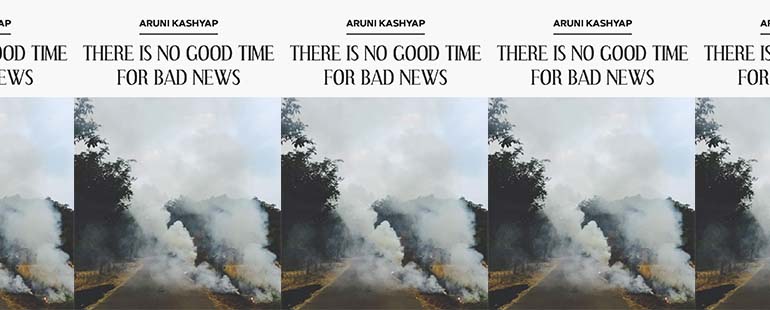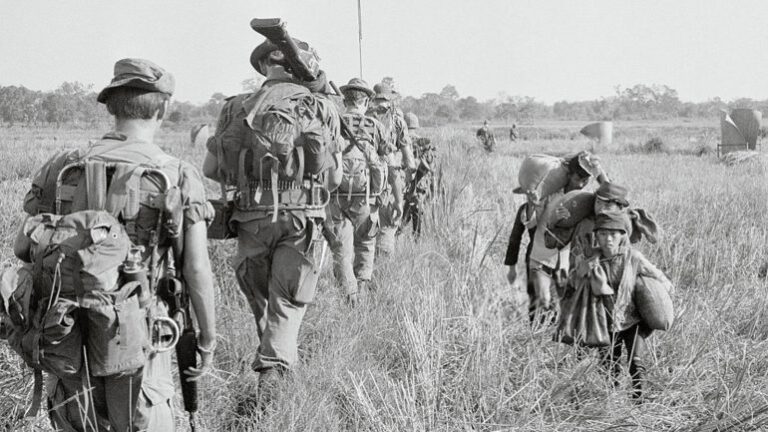Transgenerational Trauma and Testimonio Poetics in There Is No Good Time for Bad News

Aruni Kashyap’s new poetry collection, There Is No Good Time for Bad News, grapples with the violent history of an armed separatist movement in India’s northeastern state of Assam, which formed in 1979 around its demand to secede from India. In the collection’s title, Kashyap reminds us that, preoccupied with writing testimonies of globalization and nation-building, there never arrived a good time for Indian intelligentsia to reckon with the bad news of state violence in Assam. The largely haunting silence in the Indian public sphere about the trauma of lives lost, however, finds an unflinching voice in Kashyap’s poetry. Critiquing the willful blindness of national public discourse towards this trauma, Kashyap writes, in a poem titled “News from Home”:
People here,
they tell me these are lands unfamiliar, so I must not speak about them.
I should yearn for a language, which goes well with people who decide
who should know what, how much,
how many times, when, in which perspective
and how many days news from home
should take to reach where I live,
so that tears dry up, hence no TRPs.
In stark contrast to the language, in state-controlled narratives of the Assam insurgency, that sanitizes the brutality of the violence taking place, Kashyap’s poetry yearns to tell the harsh truth. Instead of repressing the region’s trauma, There Is No Good Time for Bad News revisits traumatic experiences as sites of trauma get revisited by the poetic personae. Using a myriad of poetic genres, including dramatic monologue, the epistolary form, and the retelling of folk tales, Kashyap’s poetry adopts formal conventions of testimonio, a first-person narrative of injustice popularized in Latin American literature by works like Biography of a Runaway Slave by Miguel Barnet (1968) and I, Rigoberta Menchú: An Indian Woman in Guatemala by Rigoberta Menchú (1983). Kashyap’s poems are replete with images of loss, death, and psychic wounds; the subjects of the poems bear testimonies of violence and make readers witness the inheritance of transgenerational trauma and cultural memory of insurgency.
Consider the use of testimonio in “My Aunt Talks About Being Raped by Soldiers.” In harrowing detail, the subject of the poem tells her traumatic experience of being raped by a soldier to a journalist. “But this man in green clothes / who had come with a gun / asked me to do things to him / I had never done to my husband—if I did, he would leave / my ten-year-old daughter alone,” she says. By breaking her silence about the violence done to her, she registers her resistance; Kashyap’s use of testimonio poetics likewise transforms the reader into an alibi of state perpetrated violence. The survivor’s testimony ends with a call for justice: “I can’t believe / I have to narrate such things to an unknown man, but please do write everything / on your paper’s front page / along with my picture.” In these closing lines, she urges the journalist to make her story visible so that her plea for justice can be heard by a larger audience. It is not, however, just the journalist, but also the readers of the poem who are implicated in the survivor’s call for justice. Her testimonio appeals to the reader’s ethical imperative to act against political injustice and protect the vulnerable. Here, the testimony of survival and trauma given by an otherwise silenced subaltern subject becomes an act of defiance towards state violence.
Kashyap’s use of testimonio poetics departs from conventional methods of representing trauma. Indicating how cultural representation of trauma is fraught with the problem of remembering truthfully—and then the impossible task of expressing trauma through language—modernist literature has popularized fragmented narratives and linguistic indeterminacy as common ways of portraying it. Kashyap, however, expands the possibilities of representing trauma beyond normative aesthetics by borrowing from the testimonio form. In fact, the use of free verse and lack of overt ornamentation gives Kashyap’s poetry the immediacy of witnessing violence and the authenticity of listening to trauma stories in the voice of survivors. In a recently published article on Literary Hub, “What the Poet Can Do in the Face of the Modern Colonial State,” Kashyap discusses his choice of using testimonio poetics to retell the stories of traumatized subjects:
For a poet interested in challenging the modern colonial state, which often wants to impose a monolithic idea of the nation through violent means, the testimonio can be effective in other ways. First, the form enables us to . . . defy poetic conventions, forms, structure, meter, and privilege the aural rhythms closer to the community’s voice. Secondly, the form silences and erases the poet’s authority, making them a mere scribe or editor. The poet is present in all these poems but as the silent listener. This listener is archiving and will later edit but will have no voice . . . . Finally, the form highlights the stories of survivors while honoring the stories of victims who didn’t make it.
Kashyap deploys the testimonio form precisely to the effect of rendering a voice to the silenced victims of violence. Sustaining a tenor of intimacy and immediacy, his poems are written in a chorus of voices, primarily narrating the trauma of women who most bore the brunt of state violence, in the form of sexual abuse. The testimonies of suffering and trauma in Kashyap’s poems also make readers witness the violation of human rights in Assam. In the absence of formal justice, the literary representation of traumatized people allows Kashyap to create a space for remembrance and mourning of lives lost during the violent history of the Assam insurgency.
The history of this insurgency can be traced back to the independence of India in 1947, when the British colonial rulers haphazardly partitioned the subcontinent into two sovereign nations: the Republic of India and the Islamic Republic of Pakistan (with its bipartite dominions over East Pakistan and West Pakistan). Later, in 1971, East Pakistan seceded to become Bangladesh. The bloody partition of the Indian subcontinent in 1947 was followed by one of the largest migrations in modern history, displacing an estimated fifteen million people and killing more than a million. The seismic exodus of Hindus and Muslims across newly created borders between India and Pakistan engendered an unprecedented refugee crisis. Partition also exacerbated ethnic conflicts in frontier states like Assam, which from 1947 onwards witnessed a large-scale migration of refugees from Bangladesh. The influx of Muslim and other ethnic minorities into the Hindu-dominated state of Assam fostered hostility against the refugee communities.
In 1979, the All Assam Student Union and the All Assam Gana Sangram Parishad mobilized a student-led anti-immigration movement. Against the backdrop of Hindu-Muslim ethnic conflict in Assam, anti-immigration agitation gained momentum. In 1983, riots broke out in the village of Nellie, Assam, killing an estimated 3,000 people. What began as an anti-immigration agitation demanding denial of Indian citizenship to and the deportation of refugees soon morphed into an armed separatist movement against the Indian state—the United Liberation Front of Asom (ULFA).
In the 1990s, India conducted two counter-insurgency operations to crush grassroots militant movements. In addition, the Indian state also conducted several covert militaristic operations in collaboration with surrendered militants, including the extrajudicial killings of ULFA members and their kinfolk, who were kidnapped and found later as bullet-ridden bodies and mutilated corpses. In addition, the public discourse around the Assam insurgency was tampered with by the Indian state, to reduce the complexity of the economic and political demands of the insurgent movement to a jingoistic narrative of nation-building and state security in Assam. Though triggered by post-Partition refugee crises, the alleged neglect and economic, social, cultural, and political exploitation by the Indian state were the main reasons behind the growth of secessionist movements in Assam. The Indian state has repeatedly disavowed its complicity in paralegal and covert militaristic operations in Assam; even today, most of the Indian population outside Assam remains oblivious to the extrajudicial killings. Despite taking more than thirty thousand lives and perpetuating a culture of fear, the insurgency and its traumatic afterlife are also scarcely covered in mainstream media reportage. Writers from Northeast India such as Kashyap and Indira Goswami, however, have made the subject central to their work.
Kashyap’s poetry dramatizes the inherent paradox in the literary portrayal of trauma, which trauma theorist Dori Laub has referred to as the narrative tension that abounds in trauma literature due to its “imperative to tell” and “impossibility of telling.” The tense narrative voice of There Is No Good Time for Bad News’ titular poem exemplifies the difficulty of portraying trauma. Torn between imperative and impossibility, the speaker of the poem faces the onerous task of summoning a militant’s mother to a police precinct to identify an unclaimed corpse, suspected to be her son’s bullet-ridden dead body. The narrator’s dilemma of becoming a harbinger of death is juxtaposed with the mother’s trauma, who will for thirty seconds perform the macabre ritual of examining “the wrinkles on battered bluish bodies with bitter faces.” Kashyap does not shy away from morbid imagery, instead exposing the human collateral of political violence by turning our gaze towards it. Pairing images of death and debris, Kashyap takes the reader to the epicenter of a conflicted region in which people who did not adhere to the body politic became disposable: “bodies of young men pile up / like trash in landfills of large cities.” The repeated use of corporeal imagery throughout the collection’s titular poem draws attention to how the biopolitics of the state renders the tortured body of the militant a site for exerting sovereignty and suppressing dissent.
The titular poem is also self-reflexive, as both the poet and poetic personae find themselves eluded by the right words to describe trauma with veracity. The narrator searches for the most potent metaphor to convey the mother’s grief upon seeing her son’s corpse. But no single metaphor serves the purpose; instead, the emotional overflow of agony finds relief in a cascade of images:
Like her previous visits to identify bodies, she
will crumble like a house of cards,
throw her hands up to the sky like
ascetics who feel betrayed after years of penance,
bleak like a goat that feels
that sharp edge of a knife against its neck,
scream like a woman in labor.
This metaphorical multitude meets a bathetic end in the closing lines of the poem: upon finally seeing her son’s dead body, the mother’s angst and hysteria succumb to a poignant acceptance. Kashyap writes, “But she doesn’t cry, she doesn’t wail. She walks out / with the calmness of a saint, bright like burnt gold.” Unlike the other poems in the collection that deny any closure, the titular poem offers partial closure—the mother gets purged of the anxiety surrounding her son’s disappearance; she can finally mourn.
Kashyap also uses intertextuality to show how perpetual violence has made trauma pervasive in the collective memory of Assamese people. Some characters and settings that first appeared in Kashyap’s debut novel, The House, for example, reappear in There Is No Good Time for Bad News. In the novel, Manoni is raped by Indian soldiers, and faints when she sees khaki dresses and boots or hears men in uniform speaking Hindi. Manoni’s trauma leads her to perceive the objects related to the army as a mortal threat. Kashyap illustrates this associative quality of trauma in “Fake Boots,” which is a flashback to the narrator’s childhood. She recalls finding her aunt lying under her bed with a machete clutched in her hands, “as if to fight the whole world of alien Hindi words.” In the penultimate lines of the poem, Kashyap reveals that it was the narrator playing a game of “military – military” and pretending to wear army boots that triggered the aunt’s traumatic memories. Reminiscent of Manoni’s tragic story, the poem describes how trauma trickles across generations and becomes part of the quotidian life of a community, rendering benign objects like boots and children’s games symbolic of the brutality of the military.
The poem “The House with a Thousand Novels” shares its title with Kashyap’s novel and alludes to its instances of trauma. Kashyap describes the house in an elegiac register as “a house with twenty-one—novels / forever spanning in episodic form / like long yarns.” The trope of the house as an archive of memory recurs in Kashyap’s work; he uses the image of a dilapidated house to represent the traumatized collective memory of the Assamese people. “Every day someone comes in, leaving rippling traces forever / like generational earthquakes: A wailing woman leaves a story of / oppression, licensed rape, barrenness, adultery; This is a house / with a thousand serialized novels floating in the heavy air,” he writes. The traumatic transgenerational ripple effects of “licensed rape” and “oppression” created by the “generational earthquake” that is the Assam insurgency and the Indian state’s brutal counter-insurgency operations shook the edifice of democracy in the region. Using testimonio poetics, Kashyap gives a material form to the unclaimed traumas, silenced stories, and memories of insurgency that haunt the collective memory of the Assamese community as “novels floating in the heavy air.”
The last poem of the collection is a eulogy for freedom. In it, Kashyap personifies freedom as a refugee who is always on a journey but never arrives. By narrating the collective trauma of the Assamese people, the poem yearns for freedom, equally promised to all Indians post-independence; Kashyap, however, solemnly reminds the reader of the mortal price of freedom, which Assam had to pay over the years living under the duress of political violence. Kashyap writes: “Freedom, we are still waiting / for your arrival. Until then / you will be performed / and explained, because ancient stories / tell us: Definitions have always / belonged to the definers.” Seeking freedom for Assam and critiquing the existence of state violence in post-colonial India, the poem is both a plea for peace and a war cry against political oppression. Unlike other poems that narrate an individual’s trauma and proffer singular testimonies, “Freedom” adopts a communal voice to narrate the collective trauma of Assam. As a testimonio about the absence of freedom, the poem gives narrative shape to the collective memory of insurgency and communal trauma of the Assamese people.
With its emphasis on seeking freedom, promoting justice, and restoring individual dignity, the testimonio form has proved to be a powerful decolonial literary tool, especially in the politically conflicted regions of the Global South. Kashyap also uses testimonio in his poetry to tell silenced tales of state repression in Assam as an act of political resistance. In the absence of formal justice, his poems bear witness to violations of human rights and represent the silenced voice of subaltern subjects. There is No Good Time for Bad News reminds us of the long-overdue reckoning with trauma and violence that haunts India’s post-colonial future.
This piece was originally published on October 28, 2021.


